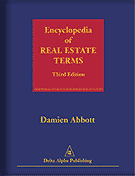
ISBN 978-0-9668946-4-6
£72.50/ US$115.00/ €87.00
Order securely online with

Subscribe
or take a 15-day Free trial

ISBN: 978-0-9668946-1-5
£15.00/ US$22.50/ €18.00
Order securely online with

ISBN: 978-0-9668946-2-2
Return to Real Estate Terms
cost approachA method or approach used to estimate the value of an improved property whereby the reinstatement cost of the buildings is assessed (after an appropriate allowance for depreciation), and the market value of the land is added based on comparable sales data. The land is assumed to be vacant and available for development for its existing use. This approach to the appraisal of a property is based on the presumption that a purchaser is prepared to pay the same sum for a property as he would pay to acquire a site and reproduce or build a similar alternative - the 'principle of substitution'. However, this presumption has limited validity and the method should be used as a last resort, i.e. when no other approach is considered applicable. In this respect, it may be said, "a building is worth its cost of replacement provided it is new, represents the highest and best use of the site, and provided its construction is justified by the expected return which it will produce." F.M. Babcock, The Valuation of Real Estate, p. 477 (1932). In other situations the method only represents an approximation to value; although it may be used as an alternative valuation in order to ascertain the amount at which a substitute property could be made available and, therefore, a test of the maximum theoretical amount that should be paid for a property.
Interagency Land Acquisition Conference. Uniform Appraisal Standards for Federal Land Acquisitions (1992), § A-6 'Cost approach'.
J.D. Eaton. Real Estate Valuation in Litigation (2d ed. 1995), Ch. 8 'Cost Approach to Value'. J.D. Fisher and R.S. Martin. Income Property Valuation (1994), pp. 227-244. Appraisal Institute. The Appraisal of Real Estate (12th ed.2001), Ch. 14 'The Cost Approach'. |
Terms in bold are defined elsewhere in the Encyclopedia —
more in the User Guide.
Return to the Sample Terms
